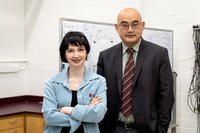Evidence for dark matter was first discovered when astronomers observed unexpected gravitational forces acting on distant cosmic
objects. These gravitational effects implied the existence of matter that could not be seen because it does not emit radiation in any
form, including light. Several decades later, this “dark” matter is still proving difficult to understand.
“We think dark matter — which makes up 25% of the matter in the universe — is a new subatomic particle that is not in the Standard
Model of physics,” says Dr. Miriam Diamond, an assistant professor at the University of Toronto. Dr. Diamond works on the Super
Cryogenic Dark Matter Search (SuperCDMS) team, a collaborative international project that aims to find the dark matter particle.
The Canadian SuperCDMS team and their partners in the U.S., India, France, Germany, Spain and the United Arab Emirates have
banded together to undertake what Dr. Diamond calls “the greatest treasure hunt in human history.”
Read the full report here:

